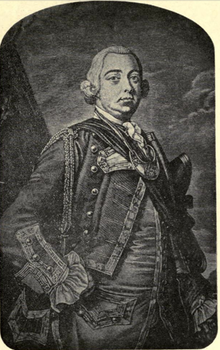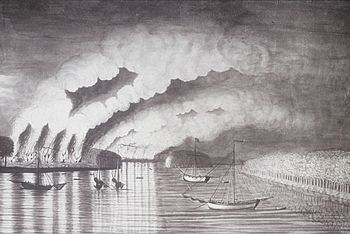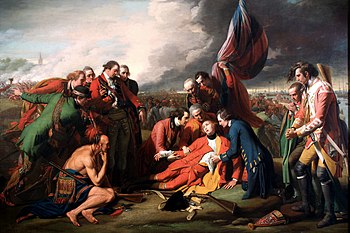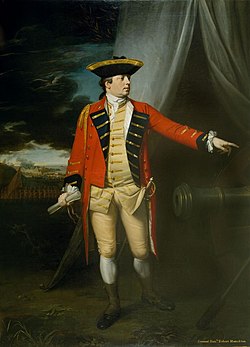Robert Monckton
This article needs additional citations for verification. (December 2012) |
Robert Monckton | |
|---|---|
 Robert Monckton by Thomas Hudson | |
| Born | 24 June 1726 Yorkshire, England |
| Died | 21 May 1782 (aged 55) |
| Allegiance | |
| Service | |
| Years of service | 1741 - 1782 |
| Rank | Lieutenant-General |
| Unit | 3rd Regiment of Foot Guards |
| Commands | 47th Regiment of Foot Commander of Fort Lawrence Commander of British expeditionary force to Fort Beausejour Second in Command to General James Wolfe at Quebec Commander of British forces in the southern provinces Commander of British forces capturing Martinique |
| Battles / wars | War of the Austrian Succession |
| Other work | MP for Pontefract Lieutenant-Governor of Nova Scotia Governor of Province of New York Governor of Berwick-upon-Tweed Governor of Portsmouth MP for Portsmouth |
Robert Monckton (24 June 1726 – 21 May 1782) was an officer of the British army and also a colonial administrator in British North America. He had a distinguished military and political career, being second in command to General Wolfe at the battle of Quebec and later being named the Governor of the Province of New York. Monckton is also remembered for his role in a number of other events in the French and Indian War (the North American theatre of the Seven Years' War), including the capture of Fort Beausejour, and the island of Martinique, as well as for his role in the deportation of the Acadians from British controlled Nova Scotia and also from French controlled Acadia (present day New Brunswick). The city of Moncton, New Brunswick, (about 50 km west of Fort Beausejour) and Fort Monckton in Port Elgin, New Brunswick are named for him.
Early life
Robert Monckton was the second son of Elizabeth Manners and John Monckton (later the first Viscount Galway) and, like many second sons of British aristocrats, he entered military service. He enlisted in 1741 at the age of 15 and received a commission in the 3rd Regiment of Foot Guards. He saw action in the War of the Austrian Succession, later staying on in Flanders after the bulk of the British Army had been recalled in 1745 to deal with the Jacobite Rebellion. He rose rapidly through the ranks, eventually becoming Lieutenant Colonel in charge of the 47th Foot in early 1752.
Monckton's father died later that year and he subsequently inherited the family controlled seat of Pontefract in Parliament. He resigned his parliamentary seat within the year, after receiving a military posting (with the 47th Foot) in Nova Scotia as commander of Fort Lawrence, which was located on the frontier with Acadia, facing Fort Beausejour across the Missaguash River. Monckton stayed in this posting for less than a year but the experience he gained during this time would prove invaluable to him during subsequent events.
Monckton was called to Halifax in 1753 to preside over a court martial but was asked to stay on as a member of the colonial council. Monckton deftly handled a minor uprising by German settlers (the Hoffman Insurrection) near Lunenburg, Nova Scotia later that year.
French and Indian War
In the winter of 1754, Governor Charles Lawrence of Nova Scotia and Massachusetts Governor William Shirley, under a general British directive, made plans to deal with French "encroachments" on the frontier of the British North American colonies. This process ultimately led to the beginning of the final French and Indian War and the onset of the Seven Years' War in North America. One of the first actions of this war was to be at Fort Beausejour and Robert Monckton, with his intimate knowledge of the local fortifications, was invited to spend the winter in Boston to assist in the planning process.
Fort Beausejour
- See main article at Battle of Fort Beauséjour

In June 1755, Monckton, commanding a fleet of 31 transports and three warships carrying 270 British regular troops and 2,000 New England militia, entered Cumberland Basin. The ships dropped anchor at the mouth of the Missaguash River and the British forces were able to land unopposed. Using Fort Lawrence as a staging area, Monckton quickly surrounded Fort Beausejour and began a careful advancement on the fort from the north by moving along the top of Aulac Ridge. A two-week siege ensued. During this time sappers were used to dig zig-zag offensive trenches until they were close enough to the fort to allow for bombardment by 13 inch mortars. The French commander of the fort, Louis Du Pont Duchambon de Vergor, being outnumbered more than four to one, realised that his position was untenable. Morale in the fort deteriorated considerably once word was received that reinforcements would not be arriving from Fortress Louisbourg. Desertions within the Acadian irregular ranks became a major problem. After one of the British mortar rounds hit the officers mess killing several French soldiers, Vergor decided to capitulate. The British forces then occupied the fort and renamed it Fort Cumberland (after the Duke of Cumberland). Following the capitulation, Monckton treated the defeated French generously and offered the garrison passage to Fortress Louisbourg. He also pardoned the Acadian irregulars. The French commander of Fort Gaspareaux, on the opposite side of the Isthmus of Chignecto, was offered (and subsequently agreed to) the same terms on the following day, thus securing the frontier of Nova Scotia. Fort Gaspareaux was subsequently renamed Fort Monckton.
Acadian deportation


Following the capture of Fort Beausejour, Governor Lawrence and the Nova Scotia Council decided that the presence of Acadian irregulars helping in the defence of the fort constituted a "violation" of Acadian neutrality. This of course ignored the fact that the vast majority of the Acadians in the fort were from French controlled Acadia and not from British controlled Nova Scotia. Nevertheless, he used this as a pretext to force the Acadian inhabitants of Nova Scotia to swear an unqualified oath of allegiance to the British crown; something that the Acadian population of Nova Scotia had been successfully able to avoid for 40 years. The Acadians again refused to comply. The die was thus cast and Lawrence subsequently issued the order to expel the Acadian population from the region. This decision was heavily influenced by the recent conflicts between the British colonial authorities and the Acadians in Nova Scotia during Father Le Loutre's War. Lawrence's ordering of the deportation of the Acadians from Nova Scotia resulted in their dispersal to the other British North American colonies, as well as to Louisiana and to France. Since Monckton and his expeditionary force (47th Foot) constituted the largest British military force in the area, Governor Lawrence placed them in charge of executing this order. On 10 August, under Lawrence's directive, Monckton rounded up 400 Acadian men (whom he had originally pardoned) and imprisoned them at Fort Cumberland to await deportation. Over the course of the next several months, the deportation effort spread to other French settlements on the Bay of Fundy and ultimately over 7,000 Acadian men, women and children were forced from their homes.
Monckton was named Lieutenant Governor of Nova Scotia later in 1755. He served in this capacity for three years; twice as acting Governor of the colony. Because of these administrative duties, he could not participate in the fall of Fortress Louisbourg in 1758, but later that same year, the now Colonel Monckton did lead a force of 2,000 men in the clearance of Acadian resistance (and the removal of the Acadian civilian population) from the lower Saint John River valley during the St. John River Campaign. This was the final act of the deportation drama. Following this action, all of Acadia came under British control.
The Plains of Abraham

Early in 1759, General James Wolfe chose Monckton to be his second in command for the assault on Quebec. Monckton's role in the siege and later the capture of Quebec was considerable. Monckton established control of the south shore of the St. Lawrence River facing Quebec and was placed in charge of the artillery batteries trained on Quebec from Lévis. Monckton later commanded the 47th Foot on the British right flank during the Battle of Beauport on 31 July.
As the siege wore on, General Wolfe and his three brigadiers came to dislike each other and disagreed as to how to conduct the battle plan.[citation needed] Monckton and the other two brigadiers, George Townshend and James Murray recommended a stealthy advance on Quebec from the west rather than another frontal attack on the Beauport shore. Wolfe eventually was swayed by their argument but instead of landing at Cap Rouge (as they recommended) he secretly chose to land at Anse au Foulon, where a narrow path led to the top of the bluff. Landing here would allow the British to gain direct access to the Plains of Abraham, only a short distance from the walls of Quebec. The landing was carried out at dawn on the morning of 13 September. Ironically, the French commander in charge of the encampment at the top of the bluff, and the first to encounter the English forces, was again the hapless de Vergor. The French encampment was quickly overrun and de Vergor shot and captured.
The Plains of Abraham were quickly gained and the British forces marshalled into fighting ranks. The French commander of Quebec, Louis Joseph de Montcalm decided to directly engage the British forces on the field. In the ensuing battle, Monckton again commanded the British right flank and was wounded in the chest. This prevented him from being present at the surrender of Quebec and, with Wolfe's death during the battle, it was Brigadier George Townshend that received the French capitulation. Monckton resented this and, although severely wounded, he roused whatever strength he had to assume command of the defeated city. Monckton commanded Quebec for a month following the capitulation and demonstrated considerable concern for (and leniency with) the conquered civilian population. This was a strategically wise decision, as winter was approaching and the occupying British forces needed the goodwill of the civilian population in order to survive the season.
Monckton was relieved of his duties at Quebec on 26 October 1759 and was reassigned to New York for convalescence. He eventually recovered from his wound and, in 1760, was appointed commander of the British forces in the southern provinces (the provinces south of New York). Here, Monckton was charged with consolidating control of the area around Fort Pitt, as well as the Niagara region and the old French fortifications in the Alleghenies. In 1761, Monckton was promoted to the rank of Major-General.
Capture of Martinique

In 1762, Monckton was given the command by Jeffrey Amherst of the British expeditionary force against Martinique. The British invasion force consisted of approximately 8,000 men and with Admiral Rodney sailed from Barbados on 5 January, arriving off Martinique on 7 January. The forces landed unopposed on 16 January, near the southern tip of the island about 5 km from the principal town of Fort Royal (Fort-de-France). Monckton patiently constructed batteries for the subsequent offensive, which was not launched until 24 January. Under covering cannon fire, heavy fighting ensued on steep and uneven terrain especially around the high ground of Morne Grenier. By 28 January, Monckton's lines were secure and he had established firing positions overlooking Fort Royal. The town surrendered on 3 February and the remainder of the island was secured by 12 February. The terms of capitulation of the island, modelled on the surrender of Guadeloupe in 1759 with only a few minor changes, suggest that Monckton was a skilful and well-informed negotiator. From 26 February – 3 March, Monckton shipped off detachments to Saint Lucia, Grenada and Saint Vincent, all of which fell without resistance. Monckton had already made his arrangements for the capture of Tobago when he received orders requiring the presence of his troops for the attack on Havana, Cuba.
The capture of Martinique by Monckton was of tremendous strategic importance to the British war effort as it gave the British a very valuable bargaining chip in the subsequent peace negotiations. The French much desired the return of this valuable island and it's sugar plantations. At the Treaty of Paris, which ended the Seven Years' War, the French willingly bargained away Canada and Acadia in return for Martinique. Voltaire at the time, famously stated that Canada was nothing more than "a few acres of snow". The capture of Martinique thus helped to disproportionately influence the course of history in North America.
Later life
Monckton returned from the Caribbean later in 1762. He was subsequently named Governor of the Province of New York. He held this position until 1765, even though he left North America for good in 1763 to return to England. In 1765 Monckton was appointed governor of Berwick-upon-Tweed. In 1770 he was promoted to the rank of Lieutenant-General. Later, Monckton became interested in becoming the British military commander of India and although he had the East India Company nomination and some royal support, he was not offered the position. Instead, he was offered the command of the British army in North America which he declined. In 1778 he became governor of Portsmouth and MP for the town in the Admiralty interest. Also that year, his younger brother, Henry Monckton was killed while leading the grenadiers at the Battle of Monmouth in New Jersey during the evacuation of Philadelphia. The following year, Robert Monckton organised Portsmouth's defences against the Armada of 1779 (during the American War of Independence). Monckton died on 21 May 1782 at age 55 and is buried in St. Mary Abbot's Church, Kensington, London.
Legacy
Monckton's actions in The Maritimes has led to his veneration in the region. The city of Moncton, New Brunswick (near Fort Beausejour) is named for him. As of 2006, the population of Metro Moncton (Moncton, Dieppe, and Riverview) is 126,424.
Monckton however remains somewhat of a controversial historical figure. He is generally reviled by the Acadian population of the Maritimes because of the deportation drama, but for the most part, Monckton was merely a subordinate following Governor Lawrence's directives. Aside from the deportation debacle, Monckton can be considered as one of the more skilled British commanders during the Seven Years' War and as a competent administrator.
Writing in 1884 about the later assessments of the historical event, noted 19th Century Historian Francis Parkman concludes, "New England humanitarianism [and by implication, like-minded others to follow], melting into sentimentality at a tale of woe, has been unjust to its own. Whatever judgment may be passed on the cruel measure of wholesale expatriation, it was not put in execution till every resource of patience and persuasion had been tried in vain."
As an example of the mixed emotions surrounding Monckton's legacy, "The Un-Canadians", a 2007 article in Beaver Magazine, includes Robert Monckton in a list of people in the history of Canada who were considered by the authors contemptible: "Lieutenant-General Robert Monckton, a colonial administrator in British North America, implemented the exile of the Acadians in 1755." [1]
See also
References
External links
- . Dictionary of National Biography. 1885–1900.
- Biography at the Dictionary of Canadian Biography Online
- Biography at the History of Parliament
- Biography of General Robert Monckton
- Use dmy dates from April 2012
- 1726 births
- 1782 deaths
- British Army generals
- British Army personnel of the War of the Austrian Succession
- British military personnel of the French and Indian War
- Members of the Parliament of Great Britain for English constituencies
- British Governors of Nova Scotia
- English politicians
- People from Yorkshire
- Younger sons of viscounts
- Colonial governors of New York
- Scots Guards officers
- 47th Regiment of Foot officers
- British MPs 1774–80
- British MPs 1780–84
